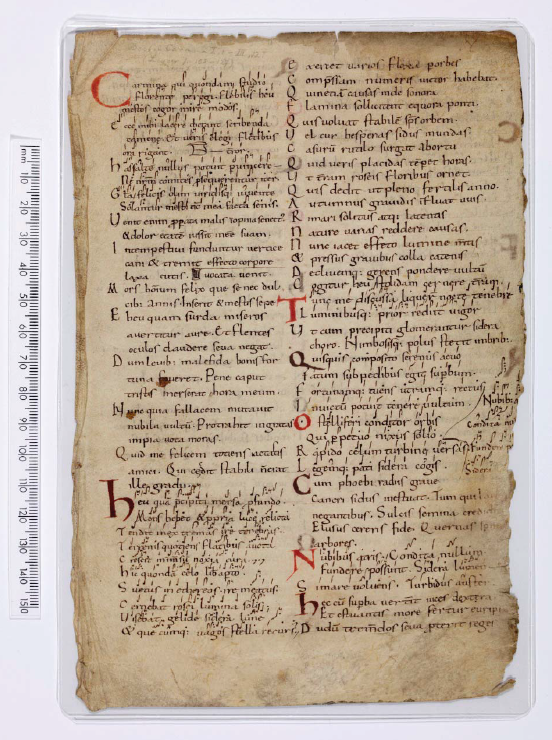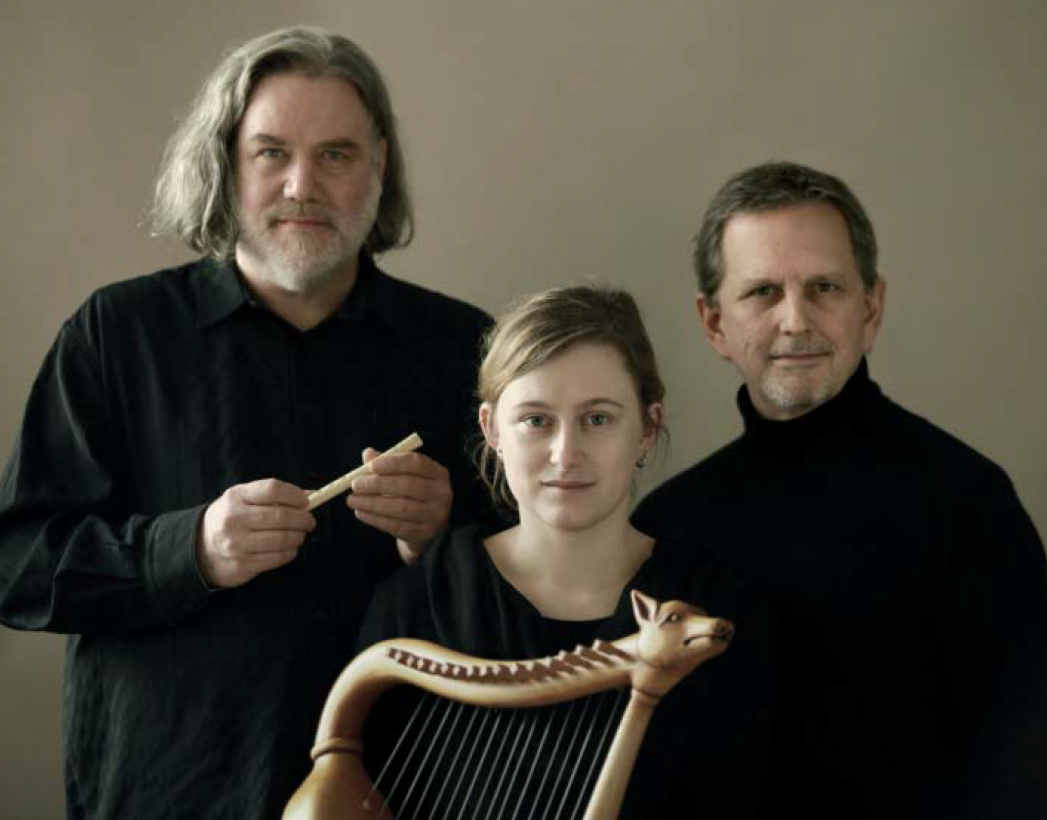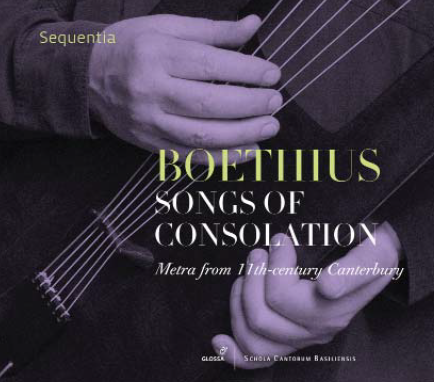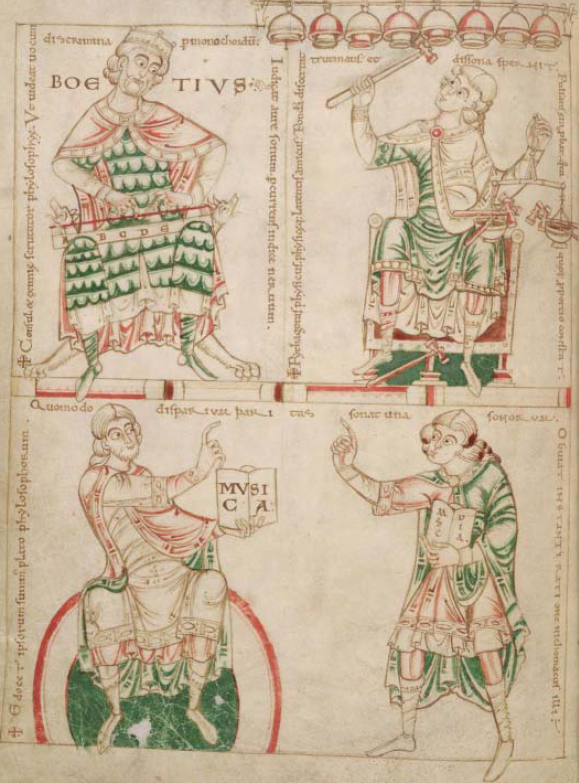Boethius Voiced by “Sequentia” (Blues Report + Interview)
Published in: 28. The Reefs of ConflictThe middle ages’ aesthetic legacy has never known such careful scrutiny as in our days.
Opening new perspectives for approaching the enigmatic era, a rare event merits embracing its declared nighttime scheduling. Members of world-renowned medieval music ensemble Sequentia, currently based in Paris, present a program of ancient songs that even for these performers, veteran rescuers of music from oblivion, stands out as extraordinary. The lyrics come from Boethius, the leading philosopher, Christian theologian and statesman of late antiquity. His final opus, the Consolation of Philosophy (De consolatione philosophiae) includes a cycle of thirty-nine metra poems. Evidence from the early middle ages, when the Consolation exercised an especially profound influence, indicates a widespread practice of singing from this cycle. Yet only quite recently did surviving notations reveal how performances may have sounded. Sequentia worked on the sung verses’ revival for two years, collaborating with Cambridge scholar Sam Barrett, who had spent the prior decade compiling and studying manuscripts with cryptic musical markings.

Leaf of Boethius’ poems from the “Cambridge Songs” manuscript, 11th century. (Cambridge University Library.)
The North American premiere of a core set of restorations takes place on June 7, 2018, as part of the Berkeley Early Music Festival, near the university campus; in two weeks, recordings of recovered material are due for release on an album titled, like the concert program, Songs of Consolation. About a millennium and a half has passed since Boethius composed Consolation of Philosophy during a year of imprisonment followed by the author’s execution. About a thousand years have passed since these melodies’ active life in European musical culture. And now, toward 10 o’clock, unusually late for the start of a classical concert, an intrigued audience gathers at a venue familiar to many musicians and music-lovers, congenial St. Mark’s Church. Almost as if for a vigil.
Three musicians face the audience. Benjamin Bagby, who founded Sequentia more than forty years ago, sings and plays harps. Additional harping and a female voice are provided by Swiss musician and scholar Hanna Marti. The third performer is Norbert Rodenkirchen, a German specialist in medieval flutes. Bagby leads the program. In between songs from the “prison letter,” he also reads Consolation fragments, further illuminating the work’s metaphysical development. In the song performances, Bagby voices Boethius, who engages in dialog with Philosophy’s classical feminine incarnation, a visitor amid his ordeal. Songs from Philosophy’s point of view are presented by Marti. Flutes and harps lend nuanced commentary to lyrics and voices.

Right to left: Benjamin Bagby, Hanna Marti, Norbert Rodenkirchen. (Photo: Johannes Ritter.)
The program’s depth and emphatic seriousness make a tremendous impression. The monotonal music unfolds in ancient modes. While tuneful, it bears kinship with the melodics of chants, with odes and epic narrative form, and strikes the modern ear as unusual. Each song plunges the listener into deeper pensiveness. Through Philosophy’s counsels, Boethius’ mournful despair gradually gives way to tranquility and courage. The work’s subject proves enthralling not only by virtue of the philosopher’s great mental tension in extremity, seeking an exit by discerning misfortune’s meaning; the music itself effectively expands the emotions in the poetic content, absorbing the listener in the captive’s lonely futility, in his groping for a single form of comfort through labors of spirit and reason.
The astonishing music escapes categorical definition. It differs from later, more popular song forms in its dignified restraint, sublimating all to the orderly integrity of the moral person. At some intuited apex, the Songs of Consolation align with certain Shostakovich vocal works, such as the Suite on Verses by Michelangelo, where everything depends on a fundamental understanding of interactions with life’s great mystery. In both cases, the hearing slowly but surely attunes to the atypical, starts to perceive the true contours of the music’s map of the invisible, to experience a need namely for this transcendence of both song and melody, for impassive, sober statements, for disengagement from emotional strata. In the harp and flute timbres — devoid of sentimentality, of superficial prettiness — harmony and atonality, softness and harshness, transparency and density uncannily coexist.

Sequentia. Boethius: Songs of Consolation. Metra from 11th-century Canterbury. Schola Cantorum Basiliensis, Glossa, 2018.
This music implies consolation through sharp focus on questions of fate, through baring their essence. Glimmers of daylight finally return, and the philosopher renews his connection with the expansive earth, the unshakeable cosmos and the eternal image of man, who ties together all creation.
So greatly do the performers merge with the work that when a text refers to Orpheus, Bagby resembles that bard’s living incarnation. Orders of ancient musicians, fallen silent, seem invoked in turn.
Yet is such silence truly inevitable? Is there no relearning to read, to hear and follow melodies whose very nature might mark them for permanence?
Sequentia’s example inspires hope.
Is Sequentia pleased with the North American premiere of Songs of Consolation?
It was a pleasure for us to perform for the audience in Berkeley — certainly one of the world’s unique experiences as well as one of the few places (aside from Cambridge) where one could dare to present such a thing. [AB: The world premiere of Songs of Consolation took place in April 2016 at Pembroke College, Cambridge University.]
What do you feel when performing the work?
One thing is the feeling while performing an individual song as an isolated event, even with its own particular message relating to the story. But quite another feeling comes from performing the song in the context of the story as I narrated it (in vastly reduced dimensions) in Berkeley. In that case, the singer begins to feel more reactive, and this can sometimes give new energy or impulse to the performance. Of course, much of the conscious brain is involved with the many technical difficulties of this music: the text, the phrasing, the dynamics, the tuning, and the interaction with an accompanying instrument. It is supreme multitasking, but that is why we rehearse so much.
What did you sense as advantages or challenges in the Berkeley performance?
The Berkeley concert was the first time we had the use of projected video titles with the translations of the sung texts, as well as the English narration which sets the songs into the context of the Consolatio narrative. The advantages were clear, and the challenges were in keeping the focus on the narrative.
Were there points at which you felt transformations in the overall concert atmosphere?
I felt some kind of transformation at certain points when the text makes clear that universal truths are being spoken which could be pertinent to our own situation today, in politics and in the general discussion about good versus evil, and especially why bad things happen to good people. Humans don’t seem to have evolved much since the early 6th century.

Leaf from a 12th-century copy of Boethius’ De institutione musica, with depictions of Boethius, Pythagorus, Plato and Nicomachus. Upper left: Boethius experiments with a monochord (canon). Upper right: Pythagorus experiments with vibrations. Left and right: Plato and Nichomacus. (Cambridge University Library.)
Did you use printed notes and lyrics? Or were you singing from memory?
We were singing from memory or from texts. At this point in the working process, musical notation is superfluous. In a few cases, above the text there might be a few medieval-style musical markings, called neumes, which indicate a certain musical motion of two or more notes, but otherwise notation is not needed.
To what extent were you improvising?
Through a long working process we have evolved ways of accompanying some of the songs, but these accompaniments are not written, nor are they strictly “improvised.” There is an extemporaneous element at all times, and there is much room for change from one performance to another. We try to surprise each other, but in subtle ways. The voices do not improvise except in the manner of phrasing or lengths of certain notes, since the notation in the medieval manuscripts really sets the course of the melody.
Were specific modes established for each song, whether in the original manuscript or in Sequentia’s interpretation?
There is no evidence of specific modes being associated with certain songs. In any case, the manuscripts do not give modes and we have to discern them according to certain gestures found in the neumes, which are typical of particular modes.
Are all the Boethian texts with musical markings held at Cambridge?
The Cambridge manuscript is only one of the more than thirty extant manuscripts containing neumes for Boethian metra. There are also many continental sources, mostly from France and Italy. This is all described in great detail in Dr. Sam Barrett’s monumental book on the Boethian metra. [AB: With reference to The Melodic Tradition of Boethius’ ‘De consolatione philosophiae’ in the Middle Ages. Monumenta Monodica Subsidia Series VII, 2 vols. Kassel: Bärenreiter, 2013.]
Apart from the album release, are there plans for any other publishing projects connected with the Songs of Consolation lyrics and music? Ways to give listeners and readers a means of deeper engagement with the material?
At the moment, nothing has been published or made available online, but I think Sam Barrett is planning on a project to bring this music more into contact with the world. The original manuscript in Cambridge University Library is in the public domain and can be consulted online. The texts of the Consolatio are also available online or in editions such as the Loeb Classics Boethius. And of course there are hundreds of translations of this seminal work, hopefully also into Russian. [AB: Indeed; Russian versions include translations by Filofilakt Rusanova (St. Petersburg, 1794) and by V.I. Ukolova and M.N. Tseitlin (Moscow: Nauka, 1990.]
What relationship does Sequentia have with musical culture in Russia?
All three of the members of Sequentia heard in Berkeley have performed in Moscow at one time or another (although never as an ensemble), under the auspices of our colleague Danil Ryabchikov, an instrumentalist and passionate medievalist who directs several Russian ensembles for medieval music, including the ensemble Labyrinthus. Danil is certainly the most important voice for European medieval music performance in Russia today. He has been a tireless organizer of concerts and recordings, and a most generous host during our visits to Moscow.
My two colleagues may be going to Moscow again in the coming year.

Speak Your Mind